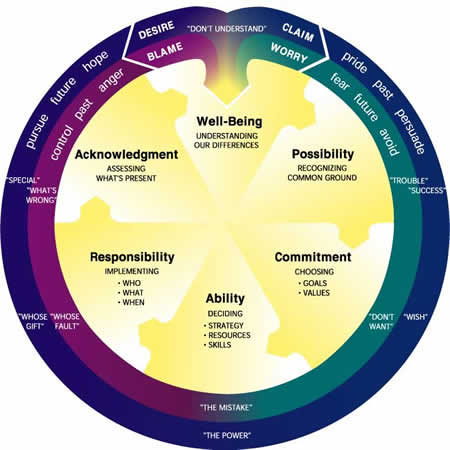
The
Mobius Model™ is a guide for understanding and facilitating development
in relationships at all levels. It is used in the U.S. and internationally
as a guide to coach individuals, develop effective teams, and facilitate
development in organizations and communities.
The
theory underlying the Mobius Model™ is grounded in cultural anthropology
and developmental psychology. The Model illustrates how our conversations
are a mirror of the quality of our relationships. It explains how differences
can become a source of creativity and development or conflict and chronic
distress.
The
Mobius Model™ offers a practical guide for leaders, coaches and facilitators
by calling attention to fundamental choices for responding when differences
arise.
The arrows at the top of the Mobius Model diagram point to these choices:
1)
Monologues
(Blame and Worry, Praise and Claim) can lead to actions that separate
us if they are not brought into dialogue.
2)
Creative Dialogue is a
respectful sharing of differing viewpoints, so that mutual understanding,
shared vision and commitment lead to collaborative action.
Monologues are recurring “stories,” which
recall old thoughts and feelings and lead to old reactions. The monologues
“blame” and “worry” for example, are stories based
on judgments that something is “wrong” and that something or
someone needs to change. What makes
a story a monologue is the speaker’s assumption that s/he knows the
whole truth and doesn’t need to listen to understand the viewpoints
of others who see and do things differently.
BLAME: When
we think others are wrong, i.e. (“she isn’t doing her job”),
the stories told are
(1) about past mistakes,
(2) express feelings of anger and frustration, and
(3) lead to attempts to control others.
WORRY: When
we think we are wrong or inadequate, the stories told, (“We will
never succeed.”) are
(1) about future trouble,
(2) express feelings of fear and inadequacy, and
(3) lead to actions to avoid anticipated trouble.
Usually stories and judgments differ about
“what’s wrong” in any situation and we may hide our actions
to control or avoid from each other. For example, the supervisor who believes
a direct report is not able to manage her job may begin keeping a record
to document mistakes before openly exploring the perceived deficiencies
with the direct report. Similarly, to make “us” (our team, our
department, our stakeholders, etc.) successful, I may try secret strategies
to fix “us” without talking with the rest of the team.
Blame and worry monologues are a very natural
response to differing viewpoints, but until mutual understanding reveals
the underlying common ground, our differences lead us to associate with
those who agree rather than to learn from those who differ with us. If
monologues are shared with a real willingness to learn, then teamwork
and collaboration are possible.
Creative Dialogue requires the willingness to listen to
understand others who see situations differently from us and to share
our viewpoints honestly, until each feels fully understood by the other/s.
Listening to understand means to learn by adding the perspectives of others
to our own, and to put aside the temptation to
·
agree
·
disagree
·
problem-solve
·
commiserate
The
qualities of relationship that emerge in dialogue, and create effective
collaboration, are mapped on the Mobius Model™ in the inside circle,
and develop in a clockwise direction as follows.
Mutual Understanding exists when each
person feels understood and understands the other(s). (It is important
to note that mutual understanding is not the same as agreement. We can
understand others without necessarily agreeing with them.)
Possibility exists when everyone recognizes
something new that is desirable and seems realistic to create.
Commitment exists when there is agreement
to priorities among goals and values that will direct action.
Capability exists when there is agreement
to a way to fulfill the commitments to which everyone has agreed.
Responsibility exists when there is
agreement to expectations about what each person or unit will do to carry
out the shared commitments.
Acknowledgment exists when there is
mutual recognition of what has been accomplished and what is still missing
for the commitments to be fully realized.
It is important to notice that, in a creative
dialogue, all the qualities of relationship must be present for all
stakeholders. For example, if someone is asked to commit
to something that they do not yet believe is possible, he or she may say “yes”
but real commitment is not present. What results is compliance, which
gets very different results than commitment.
The flow of creative dialogue in any relationship is never smooth and continuous. Differing points of view will continue to arise, especially as others are included in the dialogue. Whenever new individuals are included in the dialogue, it is important to return to mutual understanding in order to establish understanding among all participants. This process takes much less time and gets more creative results than attempts to resolve conflict after monologues have become disruptive.